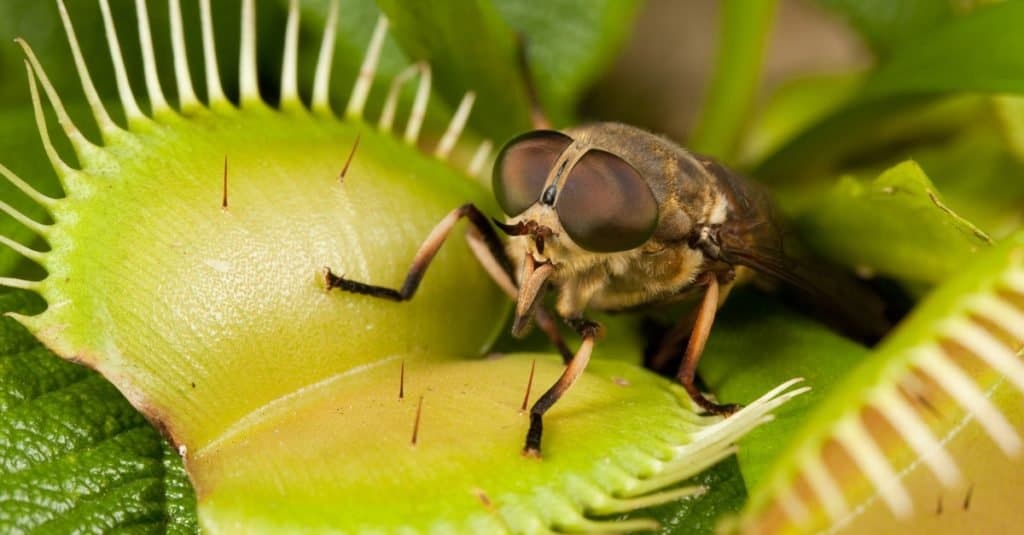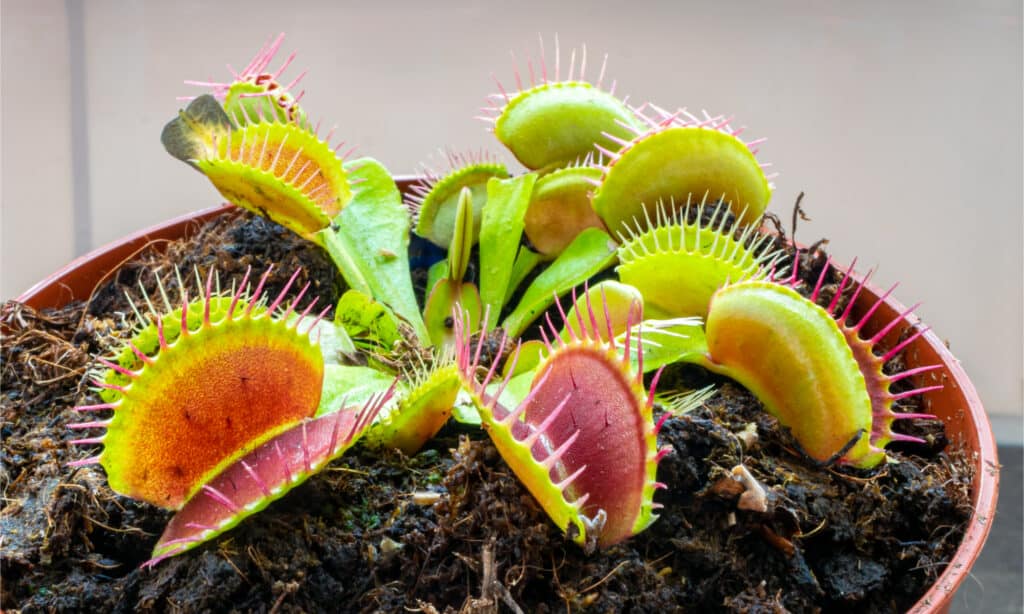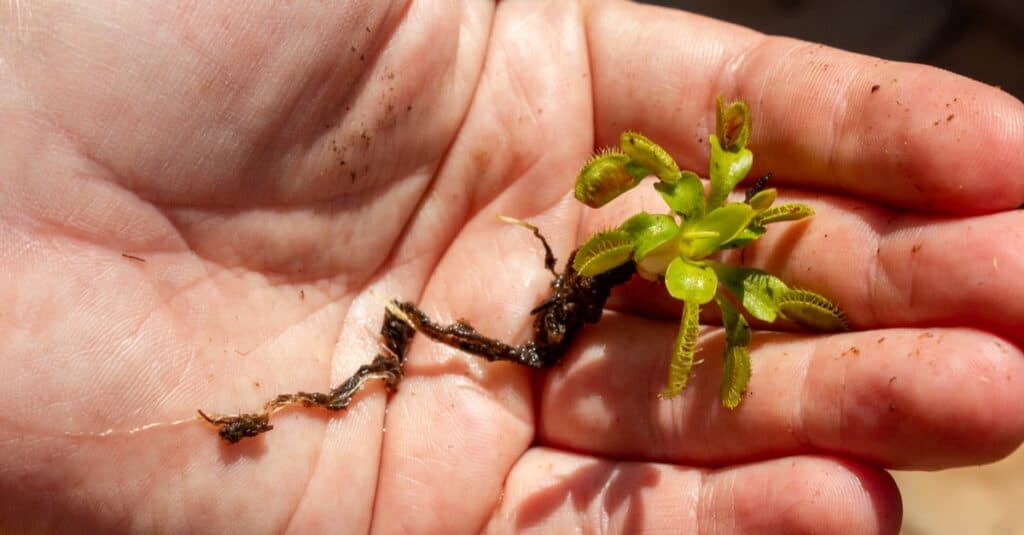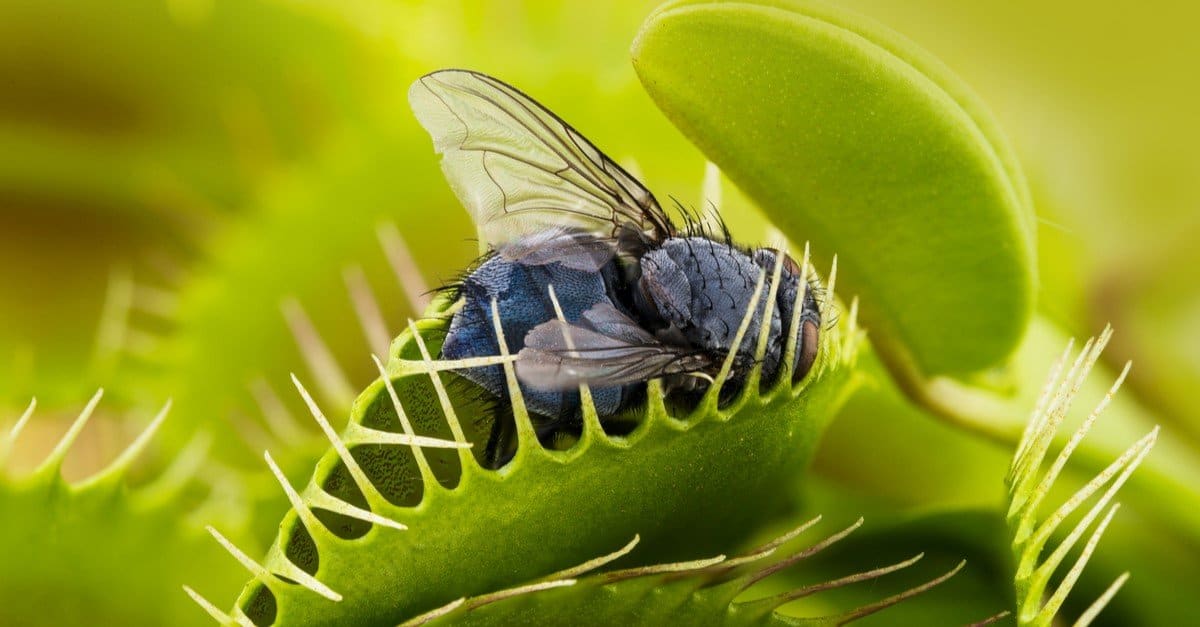Amazing Venus fly traps (Dionaea muscipula) are carnivorous plants with fascinating habits. They tempt insects near with sweet nectar, then trap them between hinged leaves and digest the unfortunate creature over ten days. A Venus fly trap takes care of the flies, but what about their own care requirements? Here’s how to take care of a Venus fly trap, including very important watering points.
Where Do Venus Fly Traps Come From?
Venus fly traps grow natively in subtropical North and South Carolina in the United States, but they’re grown and exported across the globe. This fantastic plant is threatened in the wild due to habitat reduction, pollution, and poaching. Picking Venus fly traps is a felony in North Carolina.
If you’re wondering where the name came from, it’s the Roman goddess of love, Venus. This is due to the pretty white flowers it produces in summer, but some folks argue that it actually refers to the leaf trap shape’s resemblance to female genitals.

Venus fly traps are native to subtropical North and South Carolina.
©iStock.com/CarbonBrain
How Do They Catch Flies?
Venus fly traps catch flies and digests their bodies in place of soil fertilizer, but how does that work?
The trap parts are modified leaves formed from the terminal tips. These flat, toothed leaves connect via a hinge, and tiny sensitive hairs cover their inner surface.
When an insect, such as a fly or spider, touches the trigger hair, it stimulates a response, and the leaves snap shut. Amazingly, it takes two touches to snap the trap. The first touch prepares it for action, but it only snaps if a second touch occurs on a second trigger hair within 20 seconds of the first! Alternatively, two rapid succession touches on one trigger hair produce a closure.
Botanists believe the second touch snap evolved to lessen energy wasted on falling leaves or inedible inanimate objects.
When the second touch occurs, a Venus fly trap snaps its hinged leaves shut within 1/10th of a second. It’s so refined that it tells the difference between insect touch and other stimuli, such as falling rain.
But what makes a fly enter in the first place?
Nectar.
Venus fly traps exude nectar to tempt insects to their traps. Once they’re captured, the plant dissolves them with digestive enzymes. After five trigger hairs are activated, the plant begins the digestion process. For approximately ten days, it devours the insect, then the trap springs open ready for another unfortunate victim.
That’s pretty brutal for a plant. Day of the Triffids has nothing on a Venus fly trap!

A Venus fly trap has two hinged lobes with trigger hairs on the inner surface.
©Linas T/Shutterstock.com
Best Pot for a Venus Fly Trap
Choosing the right container for a Venus fly trap will help prolong its life and boost its health.
The most important aspect is good drainage. Ensure excess water can escape via the base; otherwise, it rots the root ball and eventually kills the plant.
It’s best a pot grows with the plant, so young Venus fly traps suit a small pot with less than an inch of extra width. This is because plants with an unrestricted root run put all their effort into their roots, and we see barely any foliage or flowers.
Next up – materials. The best pot material for a Venus fly trap is either resin or plastic.
Resin
Resin, such as fiberglass, is a lightweight pot that provides plenty of insulation for its winter dormancy. Inexpensive resin pots come in a variety of colors, shapes, and sizes, so it’s easy to match up with your décor.
Plastic
Another great Venus fly trap planter is a plastic pot. Again, these lightweight pots are inexpensive and available in a rainbow of colors and shapes. One downside is that thin plastic pots may not provide much insulation in winter.
Ceramic and Terracotta
What about ceramic? Well, ceramic or terracotta pots don’t produce such a good living experience for a Venus fly trap. It’s because these materials leech liquid from the soil, causing it to dry out rapidly. They also seep out their own minerals, like sodium, into the soil, which sensitive Venus fly traps don’t like.
If you prefer ceramic, then ensure the inside is glazed to avoid leaching.
Venus Fly Trap: Best Soil
Venus fly traps grow in damp, nutrient-poor bogs and swamps, so you need to replicate that.
In the past, experts recommended peat-based compost, but modern peat-free composts designed for Venus fly traps and other carnivorous plants are better for the environment.
Alternatively, spent ericaceous compost works well. Venus fly traps prefer very little in the way of nutrients because they get those from insects. If you’re repotting a blueberry or a camellia, save their used acidic compost to repot your Venus fly traps.
Where to Grow a Venus Fly Trap
Venus fly traps grow in zones 7-10. They thrive in the sun and part shade with moist roots.
The best place to grow one indoors is on a sunny windowsill, but keep an eye out for droop. Venus fly traps like bright sunlight, but excessive heat magnified by window panes may fry it. Move the whole pot slightly out of direct light and monitor. Outside, a boggy, brightly lit area is ideal.

Carnivorous plants like the Venus fly trap love sun, but they must have damp, nutrient-poor soil.
©Menno van der Haven/Shutterstock.com
Does Venus Fly Trap Flower?
Yes, Venus fly traps flower in early spring. Pretty little white blooms sit atop slender stalks. However, experts suggest removing them because they take energy away from the plant and reduce leaf volume.
How to Plant it and Repot
Here’s how to plant up or repot your Venus fly trap.
- Use specific carnivorous plant soil or spent acidic-based compost
- Gently ease the plant from its original pot, trying not to touch the traps
- Remove some soil from the rootball, but not all
- Place fresh soil in the new pot
- Check the depth. Its lower stems should reach the same depth as its previous pot
- Add or take out soil as needed
- Place the Venus fly trap in the pot and gently backfill it
- Don’t put soil high on the stem because this may cause rot
- Water it well and place it in a bright spot to recover

Repot a Venus fly trap in spent ericaceous compost or commercial carnivorous plant soil.
©MelliwCR/Shutterstock.com
How to Water a Venus Fly Trap
Acid-loving Venus fly traps need rainwater because they have lower pH than tap or bottled water.
If you have a water butt, this is ideal for carnivorous plants. If not, place a dish or bucket outside to collect rain. Ensure the container is regularly cleaned out because rotting, fetid water will damage a Venus fly trap.
Submerge the pot in a basin of water so it can absorb the water it needs. This will keep the soil intact around the roots. However, because Venus fly traps love nutrient-depleted soil, it’s important to water from the top every few weeks. This washes away any mineral or salt deposits.
This bog lover mustn’t dry out. If its roots dry, then its trapping mechanisms won’t work properly, and it’ll quickly die. The best plan is to put yours in a basin of water every few days, but it really depends on how wet the soil is.
Try this:
Pinch the compost. Is it damp but starting to dry out? It needs more water. If it’s soggy and runs when you squeeze it, that’s enough. Leave it a few days to dry out a little.
Venus Fly Trap: Fertilizer
Don’t fertilize a Venus fly trap’s soil. Otherwise, the nutrients will likely overwhelm the plant. Instead, allow it to catch insects because they provide all the fertilizer it needs. A greenhouse or sunny outside area is a good place to put your Venus fly trap so it can attract the prey it needs to survive.
Some botanists advise catching a fly every few weeks and feeding it to a Venus fly trap, but that’s not for squeamish people. Just to note, Venus fly traps cannot use raw or cooked meat such as mince, but mealworms or crickets sold for reptile consumption are suitable. Fish food bloodworms also work well.

Venus fly traps don’t need soil fertilizer, just insect prey.
©Linda Blazic-Mirosevic/Shutterstock.com
Winter Dormancy
During fall, when daylight hours reduce, and the sunshine is less intense, indoor and outdoor Venus fly traps shed their foliage and enter a dormant state. In the wild, few insects search out nectar during winter, so this is a survival tactic.
Venus fly traps appear dead in dormancy, and many folk throw them away. There’s no need for that!
Simply move it to a cooler spot, keep the soil barely damp (not as damp as the summer months), and wait for the returning sun. As soon as spring sunshine hits the windowpanes, pop your Venus fly trap back. In a few weeks, it will display obvious re-growth.
It’s also worth noting that it’s totally normal for a Venus fly trap to develop black leaves. It’s part of the growing process. You can remove them or allow them to fall off naturally. New foliage will soon replace them.
Venus Fly Trap: Pests and Diseases
Good news. Venus fly traps pests are few and far between. Sometimes aphids and fungus gnats turn up, attracted to the damp soil. They are too small to trigger the trap, but removing them with tweezers or placing sticky traps nearby is possible. Horticultural oil or insecticidal soap may work, but be sure to purchase one suitable for carnivorous plants.
And finally, don’t set off your Venus fly trap for fun, and monitor children who universally find them appealing. It takes a lot of energy to spring the traps shut. Frequent springing weakens the plant.
Thank you for reading! Have some feedback for us? Contact the AZ Animals editorial team.








